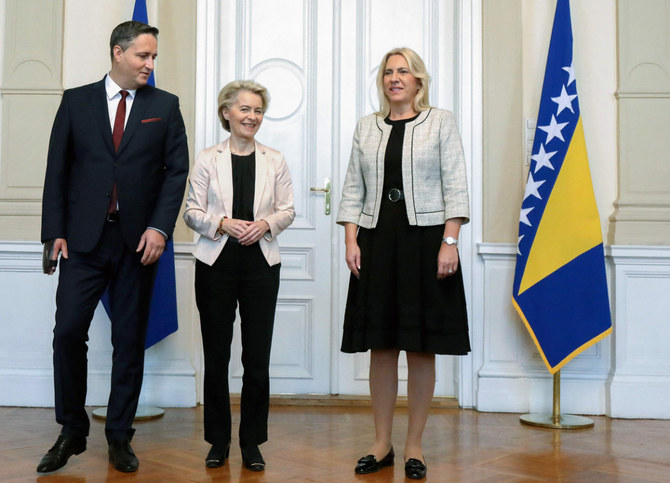Andrew Hammond
Much of the attention among European authorities is currently focused squarely on next year’s key European Parliament elections. However, a growing number of key EU officials, including European Commission President Ursula von der Leyen, are looking further ahead to the Europe of the 2030s, by which time the bloc might have grown to more than 30 members.
According to some historians, the bloc’s biggest achievement in more recent decades has been its various waves of enlargement. It is no coincidence, therefore, that von der Leyen embarked on an official visit to the West Balkans in recent days, where no fewer than six states aspire to EU membership: Albania, Bosnia and Herzegovina, Kosovo, Montenegro, North Macedonia and Serbia.
This shows how the 27-member bloc could easily grow to more than 30 members in the 2030s, given that it is not only West Balkan states that are under consideration for accession but others, too, including Ukraine, Moldova and Turkiye.
The European integration process began in the 1950s with the six founding members of the bloc and, Brexit aside, it has steadily expanded ever since. This included the accession in 2004 of eight new members from formerly communist Central and Eastern Europe — the Czech Republic, Estonia, Hungary, Latvia, Lithuania, Poland, Slovakia and Slovenia — plus the Mediterranean countries of Malta and Cyprus.
This huge enlargement resulted in many successes, including the powering of reforms in Central and Eastern Europe. For instance, that subregion’s most powerful state, Poland, has increased per capita gross domestic product almost three-fold since joining the EU.
In the two decades since, however, significant “enlargement fatigue” set in. This has meant the accession process for Turkiye and nations in the Western Balkans has been much more challenging than it was for Central and East European countries in the run-up to 2004.
Yet, the stalled enlargement process of recent years has been rejuvenated. One of the fundamental questions the bloc must address, therefore, is whether it is as serious now about another “big bang” expansion as it was 20 years ago. This week, the EU will publish an update report on the progress of aspirant states in meeting their accession targets, with a decision on formal negotiations with them expected as soon as next month.
These enlargement questions are huge and answers are needed from key existing member states if the process is to move forward. Otherwise, membership negotiations with Ukraine might begin but then move onto a long, slow road to potential accession, as has been the case with Albania, Montenegro, North Macedonia, Serbia and Turkiye.
Part of the reason these questions are so difficult to answer is that enlarging the bloc has key implications for day-to-day decision-making rules and procedures. In addition, the very nature of the EU will also change, significantly, given that the per capita GDPs of potential accession states in the West Balkans, for example, are below the EU average.
This will have consequences for EU cohesion policy, which accounts for about one-third of the bloc’s overall budget and is its key policy for helping poorer regions catch up with richer ones. Take Ukraine, for example, which, according to a recently leaked internal EU document, could get up to €61 billion ($65.5 billion) in cohesion money over seven years, post-accession. Even if cohesion budgets grow, this would leave less money for other members.
Unsurprisingly, therefore, some existing EU members have expressed concerns about moving too fast, and too far, on enlargement; it is not only decision-making that might be challenging going forward, but also budgeting.
For these reasons, key member states such as Germany and France are already looking at a detailed road map for potential future options. The former, for instance, has suggested offering EU candidate countries some early benefits before full membership is granted, including observer status at leadership summits.
German Foreign Minister Annalena Baerbock has said that this “integration-before-membership” approach would help provide positive incentives for candidate states. Moreover, there could be potential political checks and balances for any country that reversed required reforms.
France has also contributed to this debate, including its proposals for a “multi-speed” bloc. One such idea for this emerged in September from a Franco-German working group, the General Affairs Council. It proposed an inner core of select EU states, such as Germany and France, that are prepared to go further and faster with integration. Some others, but not all, among the wider EU 27 members would join this group, as is the case with the current eurozone currency union of 20 EU states.
The GAC suggests that such multi-speed options should include the possibility of new arrangements between the bloc and non-EU members that stop short of offering full membership. For instance, there might be associate memberships for countries that are part of the European single market, such as Norway, Switzerland, Iceland and Liechtenstein in the European Free Trade Area.
Beyond that, additional possibilities might exist for other states to develop future relationships with the EU. These include the new European Political Community, of which French President Emmanuel Macron is a big advocate. He believes it could serve as a potential bridge to an enlarged EU for candidate nations such as Albania, Bosnia and Herzegovina, Kosovo, Montenegro, North Macedonia, Serbia, Ukraine, Moldova and Turkiye, all of which are already members of the EPC.
If any of these nations do not ultimately become full members of the EU, the EPC could also provide a context for greater institutional proximity to the bloc. It has already, for instance, offered a new context for the UK to reach new, post-Brexit accords with some EU member states to increase cooperation, in what Prime Minister Rishi Sunak described as “a new phase of UK-EU co-operation.”
Taking all of this together, therefore, the EU has much to think through about its approach to a potential new wave of enlargement. Russia’s invasion of Ukraine has transformed the context for this process, however, and there will be huge challenges involved in any new, “big bang” expansion of membership in coming years.







